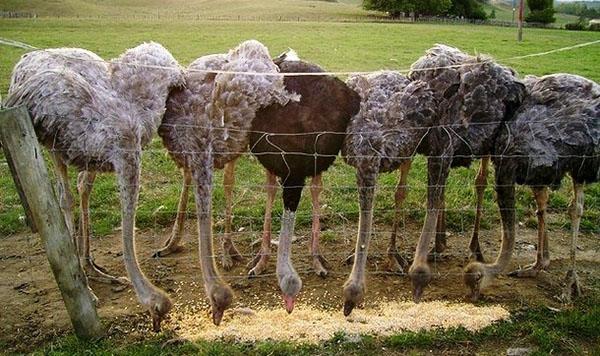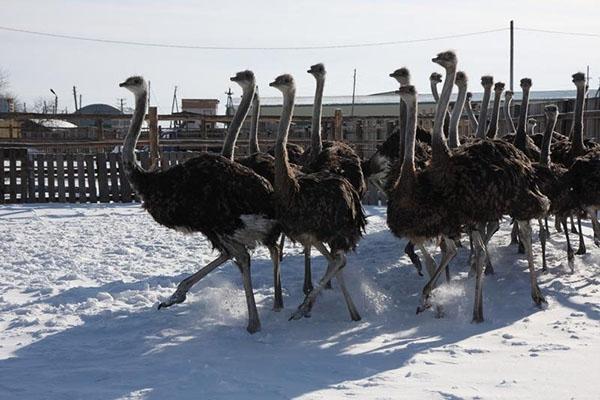What should be the maintenance of ostriches in a private courtyard
 Many people think that keeping ostriches is a complex procedure that requires effort and special knowledge. In fact, everything is much simpler. To grow these wonderful birds at home, you just need to follow a few rules.
Many people think that keeping ostriches is a complex procedure that requires effort and special knowledge. In fact, everything is much simpler. To grow these wonderful birds at home, you just need to follow a few rules.
Proper maintenance of ostriches

The weight of a domestic ostrich depends on the breed and can reach 200 kg.
 In the course of evolution, ostriches have learned to adapt in almost all climatic zones of the Earth. Their organisms are so resistant that they can withstand a very wide range of temperatures (from -250From to +350FROM). This ability helps them quickly adapt to different living conditions.
In the course of evolution, ostriches have learned to adapt in almost all climatic zones of the Earth. Their organisms are so resistant that they can withstand a very wide range of temperatures (from -250From to +350FROM). This ability helps them quickly adapt to different living conditions.
Room for ostriches
 The building must be warm and dry. A good option is barnwhere there are no rodents and other parasites that can harm the health and offspring of ostriches. The air temperature should be from +220 From to + 180 C. The main thing is to regularly ventilate their home to prevent the spread of mold and dampness.
The building must be warm and dry. A good option is barnwhere there are no rodents and other parasites that can harm the health and offspring of ostriches. The air temperature should be from +220 From to + 180 C. The main thing is to regularly ventilate their home to prevent the spread of mold and dampness.
When building the floor, do not use concrete or asphalt.
For the development of young animals and maintaining the comfort of adults, a special poultry house is built, which needs to be suitable in many ways. In size, it should correspond to the number and size of adult birds. The ceiling should be 1 meter above the ostrich's head (that is, about 3 meters). The windows are 80x80. For sufficient sunshine, the height is 1 meter from the floor.
The doorway is needed for the free passage of the bird, so it is better to make it wider (about 1 meter) and higher (2 meters minimum). These birds sleep on a straw bed.
Standard poultry house must contain:
- A protected area where the feed will be stored. It must be sealed and rodent-proof.
- Forage tanks located half a meter from the ground and two thirds full.
- Drinking bowls (water must be renewed every day).
- Device for mixing and feeding mineral additives.
- Radiators, electric heaters or other heating devices.
- Incubators (there should be several of them).
The floor in the barn where the ostriches live should be made of wood or sand. Earthen floors are also good. The walls should be covered with boards, but care must be taken to prevent parasites from entering them.
 The walking area should be covered with sand or gravel, well lit, and protected from cold, northerly winds. The fence is installed 250-300 centimeters high from a small (cell width up to 3 centimeters) metal mesh.
The walking area should be covered with sand or gravel, well lit, and protected from cold, northerly winds. The fence is installed 250-300 centimeters high from a small (cell width up to 3 centimeters) metal mesh.
For each adult, it is imperative to allocate at least 5 m2 free walking area. The optimal indicators are 10 m2.
Features of the mating season
 The mating season for these flightless birds begins in May and ends in October. During this time, each male provides several (up to 4) females. Each of them rushes once every 3-4 days.
The mating season for these flightless birds begins in May and ends in October. During this time, each male provides several (up to 4) females. Each of them rushes once every 3-4 days.
Females are able to reproduce as early as 1.5-2 years after birth, but in males, reproductive age occurs only after 2-2.5 years.
The male ostrich, when it is ready to breed, begins to attract potential mates by stretching its neck and fluffing its wings. Its legs and the area around its beak turn red, indicating that it is mature enough to produce offspring. Fertilization can occur up to 35 years, then the period of reproductive activity decreases.
How to feed ostriches?
 Of course, special birds require special nutrition. Monotonous feeding of ostriches from day to day will not work if you plan to raise healthy and strong livestock. Although the feeding process itself is not distinguished by unique techniques.
Of course, special birds require special nutrition. Monotonous feeding of ostriches from day to day will not work if you plan to raise healthy and strong livestock. Although the feeding process itself is not distinguished by unique techniques.
The ostrich's diet should include:
- hay and straw fodder;
- fresh juicy grass (clover, nettle or alfalfa);
- minerals such as calcium, fluorine, phosphates, gravel and shell rock;
- vitamins (especially group B);
- fish and bone meal;
- fresh fruits, vegetables (pumpkin, potatoes, radishes, apples and others);
- cereals and cereals;
- silage.
However, young animals are fed with grass mixtures, compound feed, protein, which should be about 20% in the composition. Everything is crushed and mixed. Protein foods (boiled eggs or cottage cheese) can be added to the diet.
Breeding ostriches
 One ostrich egg reaches two kilograms. On average, a female can lay 60 eggs per year, but sometimes this figure rises to 80 pieces. The male in the first year of puberty is not able to produce a full-fledged brood. There will be no chick inside the shell. The most active reproductive performance is achieved in the second and third years of life.
One ostrich egg reaches two kilograms. On average, a female can lay 60 eggs per year, but sometimes this figure rises to 80 pieces. The male in the first year of puberty is not able to produce a full-fledged brood. There will be no chick inside the shell. The most active reproductive performance is achieved in the second and third years of life.
If the male is older than the female, the number and frequency of laid eggs increases.
Breeding ostriches at home can be influenced by:
- weather;
- food;
- the conditions in which the birds live;
- availability of a playground and the possibility of independent walking.
The incubator has a temperature of 350 C, and humidity 30% in free idle and 70% during incubation (42 days). The chance of giving birth to healthy live chicks is increased if the egg has a lot of pores. The more - the higher the hatchability. It should also be remembered that only one egg size can be placed in one incubator chamber. This is an important condition that must be observed.
Eggs for incubation should be collected immediately after laying. To hatch healthy young, the device must be disinfected. The most effective way is to use a hydrogen peroxide solution. You need to place a container with liquid on the floor and put a fan. Ventilate the incubator after 2 hours.
How to keep chicks?
 Ostrich cubs are very independent, because they do not need time to open their eyes or learn to walk. They are kept in a poultry house with a density of 1 chick per 1 square meter (over time, personal space increases to 10 m2). For the first 20 days, keep babies on a straw pillow.
Ostrich cubs are very independent, because they do not need time to open their eyes or learn to walk. They are kept in a poultry house with a density of 1 chick per 1 square meter (over time, personal space increases to 10 m2). For the first 20 days, keep babies on a straw pillow.
For the first three days, they feed on those components that remain in the yolk sac. On the fourth day, you can already give chopped food (fresh herbs, cottage cheese, eggs) and water.
 It will take a minimum of effort and time to teach young ostriches to eat on their own. It is enough to sprinkle food on a flat, smooth surface and use your fingers to depict pecking food. Kids will repeat the movements they see and learn to take food themselves.
It will take a minimum of effort and time to teach young ostriches to eat on their own. It is enough to sprinkle food on a flat, smooth surface and use your fingers to depict pecking food. Kids will repeat the movements they see and learn to take food themselves.
In order for the chicks to get used to filling the stomach with small stones, a container with coarse sand is placed separately for each.
Chicks also need bacteria to produce healthy microflora in the body. In order to get what they need, small ostriches naturally eat parental droppings, but at home you can provide them with probiotics.
 After a week, the chicks can already be fed compound feed... The diet must include fresh herbs and chopped vegetables.After two months, the ostriches are fed a rougher food containing certain minerals and vitamins. Compound feed is given in granules up to 8 millimeters. After another month, cake and yeast are added.
After a week, the chicks can already be fed compound feed... The diet must include fresh herbs and chopped vegetables.After two months, the ostriches are fed a rougher food containing certain minerals and vitamins. Compound feed is given in granules up to 8 millimeters. After another month, cake and yeast are added.
Up to six months, babies are fed 5 times a day, then 3 or 4. A year after birth, the bird is already considered an adult, so it is fed no more than twice a day.
It is imperative to provide ostriches with fresh clean water along with dry food. This will aid digestion and the normal development of the young. If everything is done correctly, then in a fairly short time it will be possible to grow an ostrich weighing about 200 kilograms.
What can harm your health?
 On ostrich farms, diseases occur suddenly and pass in the form of an epidemic. These are mainly diseases associated with the gastrointestinal tract and respiratory tract.
On ostrich farms, diseases occur suddenly and pass in the form of an epidemic. These are mainly diseases associated with the gastrointestinal tract and respiratory tract.
To prevent such diseases you need:
- Clean the house and pastures every day.
- Disinfect feeders and drinkers regularly.
- Wear gloves when working on the farm.
- Analyze ostrich droppings regularly for parasites or infections.
- Inoculate birds.
- Examine the area for rodents.
Workers dealing with the territory and directly with ostriches must undergo medical examinations. The farm should have a specially designated quarantine place for the sick, so that other healthy birds do not get infected during treatment.
Observing all the rules given above, you can not only raise ostriches for your farm, but also provide healthy and strong offspring for these birds for many generations to come.